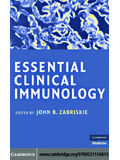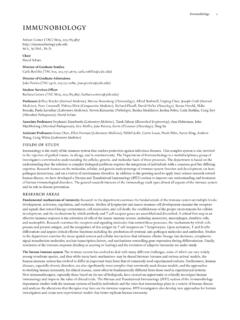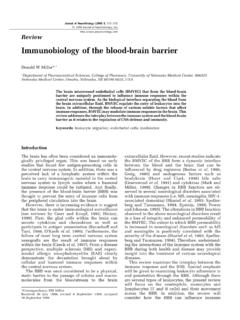Transcription of Immunobiology - Lambris
1 Immunobiology 217 (2012) 1111 1116 Contents lists available atSciVerse ScienceDirectImmunobiologyjournal and dysbiosis in periodontal diseaseGeorge Hajishengallisa, , John D. Lambrisb, aUniversity of Pennsylvania School of Dental Medicine, Department of Microbiology, Philadelphia, PA 19104, USAbUniversity of Pennsylvania School of Medicine, Department of Pathology and Laboratory Medicine, Philadelphia, PA 19104, USAarticle infoArticle history:Received 24 June 2012 Received in revised form 13 July 2012 Accepted 14 July 2012 Keywords:InflammationDysbiosisComplement PeriodontitisKeystone pathogenabstractSignaling crosstalk between complement and Toll-like receptors (TLRs) normally serves to coordinatehost immunity. However, the periodontal bacteriumPorphyromonas gingivalisexpresses C5 convertase-like enzymatic activity and adeptly exploits complement TLR crosstalk to subvert host defenses andescape elimination.
2 Intriguingly, this defective immune surveillance leads to the remodeling of theperiodontal microbiota to a dysbiotic state that causes inflammatory periodontitis. Understanding themechanisms by whichP. gingivalismodulates complement function to cause dysbiosis offers new targetsfor complement therapeutics. 2012 Elsevier GmbH. All rights pathogens which successfully disarm, suppress, ordelay host defenses target preferentially innate immunity (Finlayand McFadden 2006) and particularly key systems such as comple-ment and the Toll-like receptor (TLR) family of pattern-recognitionreceptors (Hajishengallis and Lambris 2011). Collectively, comple-ment and TLRs sense pathogens through pattern recognition and missing-self recognition strategies and trigger the activation ofantimicrobial and inflammatory responses, as well as the initiationof the adaptive immune response (Kawai and Akira 2010; Ricklinet al.)
3 2010). Until relatively recently, both systems were primar-ily investigated as separate entities. However, a substantial bodyof literature has demonstrated extensive crosstalk between com-plement and TLR signaling pathways (Hajishengallis and Lambris2010; Hawlisch et al. 2005; la Sala et al. 2005; Zhang et al. 2007).Both synergistic and antagonistic interactions between comple-ment and TLRs have been described which apparently serve toinvigorate the host response or regulate it to prevent unwarrantedinflammatory responses (Ricklin et al. 2010). Therefore, pathogenstargeting complement and/or TLRs have the opportunity to infil-trateanextensivenetworkofsignaling pathwaysinwaysthatcouldimpairinnatehostd efenseand,moreover,deregulatetheinductio nof adaptive immunity or divert it in ways that favor their survival. Corresponding author. Corresponding Lambris ).In this review we focus onPorphyromonas gingivalis, a gram-negative oral anaerobic bacterium recently shown to manipulatecomplement TLR crosstalk to enhance its survival and virulence(Hajishengallis et al.
4 2007; Hajishengallis et al. 2011; Liang et ; Wang et al. 2007; Wang et al. 2010)(Fig. 1). Importantly,these subversion mechanisms are highly relevant in the contextof the collective virulence of the microbial community in whichP. gingivalisresides. Specifically,P. gingivaliscan act as a key-stone pathogen which remodels the commensal microbiota into adysbiotic partner that disrupts the homeostatic balance with thehost tissue leading to destructive inflammation in periodontitis(Hajishengallis et al. 2011)(Fig. 2).Periodontitis is a biofilm-driven chronic inflammatory diseasethat affects the tooth-supporting tissues (periodontium) leading,in some cases, to tooth loss (Pihlstrom et al. 2005). This oral dis-ease affects the majority of adults, whereas an estimated 10 15%develops severe periodontitis, which increases the patients riskfor atherosclerosis, aspiration pneumonia, diabetes, adverse preg-nancy outcomes, and perhaps rheumatoid arthritis (Genco andVan Dyke 2010; Lalla and Papapanou 2011; Lundberg et al.
5 2010;Pihlstrom et al. 2005; Tonetti et al. 2007; Xiong et al. 2006).Periodontitis is characterized by dramatic changes in the num-bers and composition of the periodontal bacterial communityrelative to health (Moore et al. 1982; Socransky 1977; Socranskyand Haffajee 2005). It has recently been proposed that peri-odontitis fundamentally represents disruption of host microbialhomeostasis caused by dysbiosis of the periodontal microbiota(Darveau 2010; Hajishengallis et al. 2011). According to this notion,changes in the relative abundance of individual components ofthe microbiota compared to their abundancies in health can lead0171-2985/$ see front matter 2012 Elsevier GmbH. All rights Hajishengallis, Lambris / Immunobiology 217 (2012) 1111 1116 Fig. of signaling crosstalk byP. gingivalisinteracts withToll-likereceptor(TLR)-2(aspartofaCD 14 TLR2 TLR1signalingcomplex)andwithTLR4.
6 The activation of TLR4 is suppressed by the bacterium s atypical lipopolysac-charide which acts as an antagonist. The TLR2 response is manipulated throughcrosstalk with other innate receptors. By means of Arg-specific cysteine proteinasesthat release biologically active C5a from C5,P. gingivalisactivates the C5a receptor(C5aR) and induces intracellular Ca2+signaling which synergistically enhances theotherwise weak cAMP responses induced by TLR2 activation alone. Maximal cAMPinduction requires the participation of CXC-chemokine receptor 4 (CXCR4), whichis activated directly by the bacterium s fimbriae. The resulting activation of thecAMP-dependent protein kinase A (PKA) inactivates glycogen synthase kinase-3 (GSK3 ) and inhibits the inducible nitric oxide synthase (iNOS)-dependent killingof the pathogen in macrophages. An additional pathway induced downstream ofTLR2 is an inside out signaling pathway, mediated by RAC1, phosphatidylinositol-3kinase (PI3K) and cytohesin 1 (CYT1), which transactivates complement receptor-3(CR3).
7 Activated CR3 bindsP. gingivalisand induces extracellular signal-regulatedkinase-1/ERK2 signaling, which in turn selectively downregulates IL-12 p35 and p40mRNA expression through suppression of interferon regulatory factor 1 (IRF1). Inhi-bition of bioactive IL-12, and secondarily IFN , leads to impaired immune clearanceofP. and Lambris (2011).to alterations in the host microbial crosstalk sufficient to initiateinflammatory gingivalisis a quantitatively minor component ofperiodontal pathogenic biofilms, its presence has been associatedcomplement impaired host defense inflammation enhanced complement activation by dysbiotic microbiota 1 3 2 4 5 periodontal bone destruction immune subversion enhanced bacterial growth P. gingivalis altered composition & increased counts commensal microbiota gingi-valissubverts complement and impairs host defense leading to altered compositionand increased numbers of periodontal commensal bacteria which, in turn, causecomplement-dependent periodontal inflammation and bone loss.
8 The inflamma-tory environment is favorable to further bacterial growth as it provides the dysbioticmicrobiota with a nutrient-rich gingival inflammatory exudate. Numbers indicate apossible sequence of events, although the overall process represents a self-feedingcycle that drives and sustains persistent progressive bone loss in periodontitis patients (Chaves et ; Doungudomdacha et al. 2000; Kumar et al. 2006; Mooreet al. 1982; Moore et al. 1991; Socransky et al. 1998). However,the fundamental mechanism by whichP. gingivalismay contributeto a polymicrobial disease such as periodontitis has remained elu-sive until recently. As alluded to above, useful insights have beenprovided by a study in the mouse model of periodontitis whichdemonstrated thatP. gingivaliscan act as a keystone pathogenwhich reshapes an otherwise harmless periodontal microbiota intoa disease-provoking microbiota (Hajishengallis et al.)
9 2011).The capacity ofP. gingivalisto act as a keystone member of theperiodontal microbiota is dependent, in great part, upon its abil-ity to exploit complement and TLRs (Hajishengallis et al. 2011)(Table 1). Subversion of complement and TLRs might also accountfor the ability ofP. gingivalisto relocate to systemic tissues andcontribute to disease. In this regard,P. gingivalisis a commonisolate from aspiration pneumonia and lung abscesses (Finegold1991; Okuda et al. 2005) and has been detected in a viable state inatherosclerotic plaques (Kozarov et al. 2005). Below we summarizeand discuss recently established mechanisms wherebyP. gingivaliscan manipulate complement to sabotage its functions and its pro-ductive interactions with TLRs. In this way, the host response isdiverted to favor the pathogen and its microbial community lead-ing to dysbiosis and destructive inflammation in the inhibition byP.
10 GingivalisThe interactions ofP. gingivaliswith complement are com-plex and include both inhibitory and stimulatory effects (Krausset al. 2010)(Table 1). This is not surprising given that com-plement mediates diverse functions (Ricklin et al. 2010), someof which could involve effective antimicrobial action (targets ofinactivation), while certain complement-dependent inflammatorypathways could benefit the periodontal bacteria (targets of activa-tion).P. gingivaliscan suppress complement activation, regardlessof the initiation pathway involved (classical, lectin, or alternative)through gingipain-dependent degradation of C3 (Popadiak et ). All three gingipain enzymes can cause complement inacti-vation, although the Arg-specific enzymes (HRgpA and RgpB) aremore potent than the Lys-specific gingipain (Kgp) (Popadiak et ). As a consequence of complement inhibition, the depositionof opsonins or the membrane attack complex on the surface ,whereasablationofitsgingipainactivityby chemicalorgeneticmeansreversestheseeffec ts(PotempaandPike2009).











